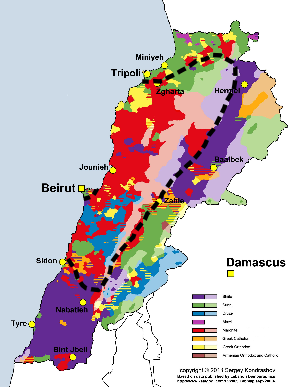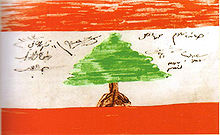Greater Lebanon
State of Greater Lebanon (1920–1926) État du Grand Liban دولة لبنان الكبير Lebanese Republic (1926–1943) République Libanaise الجمهورية اللبنانية | |||||||||
|---|---|---|---|---|---|---|---|---|---|
| 1920–1943 | |||||||||
Henri Gouraud | |||||||||
• 1944–1946 (last) | Étienne Paul Beynet | ||||||||
| President | |||||||||
• 1926–1934 (first) | Charles Debbas | ||||||||
• 1943 (last) | Émile Eddé | ||||||||
| Prime Minister | |||||||||
• 1926–1927 (first) | Auguste Adib Pacha | ||||||||
• 1943 (last) | Riad Al Solh | ||||||||
| Historical era | Interwar period | ||||||||
• State created | 1 September 1920 | ||||||||
| 23 May 1926 | |||||||||
| 22 November 1943 | |||||||||
• Withdrawal of French forces | 17 April 1946 | ||||||||
| Currency | Syrian pound (1920–1939) Lebanese pound (1939–1946) | ||||||||
| ISO 3166 code | LB | ||||||||
| |||||||||
The State of Greater Lebanon (
The state was declared on 1 September 1920, following Decree 318 of 31 August 1920,
Background
Name and Conception

The term Greater Lebanon alludes to the almost doubling of the size of the
Nujaym was building on his widely read 1908 work La question du Liban, a 550-page analysis which was to become the foundation for arguments in favor of a Greater Lebanon.[4] The work argued that a significant extension of Lebanon's boundaries was required for economic success.[4] The boundaries suggested by Nujaym as representing the "Liban de la grande époque" were drawn from the map of the 1860-64 French expedition, which has been cited as an example of a modern map having "predicted the nation instead of just recording it".[5]
Paris Peace Conference

On 27 October 1919, the Lebanese delegation led by
Proclamation

Following the peace conference, the French were awarded the
On 24 August 1920, French Prime Minister Alexandre Millerand wrote to Archbishop Khoury: "Your country's claims on the Bekaa, that you have recalled for me, have been granted. On instructions from the French government, General Gouraud has proclaimed at Zahle's Grand Kadri Hotel, the incorporation into Lebanon of the territory that extends up to the summit of the Anti-Lebanon range and of Hermon. This is the Greater Lebanon that France wishes to form to assure your country of its natural borders."
World War II and Later history

Syria-Lebanon Campaign
During
After the fighting ended in Lebanon, General Charles de Gaulle visited the area. Under various political pressures from both inside and outside Lebanon, de Gaulle decided to recognize the independence of Lebanon. On 26 November 1941, General Georges Catroux announced that Lebanon would become independent under the authority of the Free French government.[9]
Levant Crisis and Independence
Elections were held in 1943 and on 8 November 1943, the new Lebanese government unilaterally abolished the mandate. The French reacted by throwing the new government into prison. In the face of international pressure, the French released the government officials on 22 November 1943, and accepted the independence of Lebanon.
In October, the international community recognized the independence of Lebanon, which was admitted as a founding member of the United Nations along with Syria. On 19 December 1945, an Anglo-French agreement was eventually signed – both British forces from Syria and French forces from Lebanon were to be withdrawn by early 1946.
Government
The first

| History of Lebanon |
|---|
 |
| Timeline |
|
|
A custom of selecting major political officers, as well as top ranks within the public administration, according to the proportion of the principal sects in the population was strengthened during this period. Thus, for example, the president ought to be a
At the end of Debbas's first term in 1932,
Émile Eddé was elected president on 30 January 1936. A year later, he partially reestablished the Constitution of 1926 and proceeded to hold elections for the Chamber of Deputies. However, the Constitution was again suspended by the French high commissioner in September 1939, at the outbreak of World War II.
High Commissioners of the Levant
The High Commissioner of the Levant, named after 1941 the General Delegate to Syria and Lebanon, was the highest ranking authority representing France in the French-mandated countries of Syria and Lebanon. The French mandate promoted French culture and the 
Education
Demographics
The first and only official religious census of Greater Lebanon was carried out in 1932 which concludes that the population is roughly split equality between Muslims and Christians, the largest sects being Maronite Christianity, Sunni Islam and Shia Islam.[12]
| Christians | ||
|---|---|---|
| Sect | Population | Percentage |
| Maronite | 226,378 | 28.8 |
| Greek Orthodox | 76,522 | 9.7 |
| Melkite Catholic | 46,000 | 5.9 |
| Other | 53,463 | 6.8 |
| Total | 402,363 | 51.2 |
| Muslims | ||
| Sect | Population | Percentage |
| Sunni | 175,925 | 22.4 |
| Shiite | 154,208 | 19.6 |
| Druze | 53,047 | 6.8 |
| Total | 383,180 | 48.8 |
In total 785,542 people lived within the boundaries of Greater Lebanon in 1932.[13]
See also
- Emir Majid Arslan II
- Sykes-Picot Agreement
- Patriarch Elias Hoayek
- San Remo conference
- Mount Lebanon
- French Mandate of Syria
- Battle of Maysalun (1920)
- Syria-Lebanon Campaign(1941)
- List of French possessions and colonies
- French colonial empire
References
- ISBN 978-1-61069-024-9.
- ^ "Archived copy". Archived from the original on 24 February 2021. Retrieved 24 July 2008.
{{cite web}}: CS1 maint: archived copy as title (link) - ISBN 978-0-8156-6086-6.
This article, bearing the dateline of Jounieh, July 10, 1919, constitutes, together with Albert Naccache's "Notre avenir économique published also in La Revue Phénicienne (July 1919), perhaps some of the earliest written and public references to a Grand Liban. For instance, the term does not appear to have been used seven months earlier by the first Lebanese delegation to Paris - at least not in its official releases. Or to cite a later example, the term was not used in the important correspondence from Clemenceau to Maronite Patriarch Huwayik dated 10 November 1919
- ^ ISBN 978-0-8014-9523-6.
Nujaym's formulation was to become the basis for Lebanese Christian arguments in favor of a Greater Lebanon. It stressed the national rather than economic aspects of that goal. Only extended boundaries would enable Lebanon to exist as an independent state. Nujaym told the European public that the Lebanese question required a definite solution: the establishment of an independent Christian state.
- ISBN 978-1-136-18453-6.'s)] study shows that the modern map in some cases predicted the nation instead of just recording it; rather than describing existing borders it created the reality it was assumed to depict. The power of the map over the mind was great:"[H]ow could a nation resist being found if a nineteenth century map had predicted it?" In the Middle East, Lebanon seems to offer a corresponding example. When the idea of a Greater Lebanon in 1908 was put forward in a book by Bulus Nujaym, a Lebanese Maronite writing under the pseudonym of M. Jouplain, he suggested that the natural boundaries of Lebanon were exactly the same as drawn in the 1861 and 1863 staff maps of the French military expedition to Syria, maps that added territories on the northern, eastern and southern borders, plus the city of Beirut, to the Mutasarrifiyya of Mount Lebanon. In this case, too, the prior existence of a European military map seems to have created a fact on the ground.
His [(Thongchai Winichakul
- ^ a b c Salibi 1990, p. 26: "Since the turn of the century, however, the Maronites had pressed for the extension of this small Lebanese territory to what they argued were its natural and historical boundaries: it would then include the coastal towns of Tripoli, Beirut, Sidon and Tyre and their respective hinterlands, which belonged to the Vilayet of Beirut; and the fertile valley of the Bekaa (the four Kazas, or administrtative districts, of Baalbek, the Bekaa, Rashayya and Hasbayya), which belonged to the Vilayet of Damascus. According to the Maronite argument, this 'Greater Lebanon' had always had a special social and historical character, different from that of its surroundings, which made it necessary and indeed imperative for France to help establish it as an independent state. While France had strong sympathies for the Maronites, the French government did not support their demands without reserve. In Mount Lebanon, the Maronites had formed a clear majority of the population. In a 'Greater Lebanon', they were bound to be outnumbered by the Muslims of the coastal towns and their hinterlands, and by those of the Bekaa valley; and all the Christian communities together, in a 'Greater Lebanon', could at best amount to a bare majority. The Maronites, however, were insistent in their demands. Their secular and clerical leaders had pressed for them during the war years among the Allied powers, not excluding the United States."
- ^ Harris 2012, pp. 173–174
- ^ Salibi 2003, p. 33, "At the battle of the Maysalun Pass, in the Anti-Lebanon, the French did crush the forces of King Faysal in July 1920, which finally opened the way for their occupation of Damascus. Maronite volunteers reportedly fought with the French in the battle, and there were open Maronite celebrations of the French victory, or rather of the Arab defeat. This was not to be forgotten in Damascus."
- ^ a b Hadden, Briton; Luce, Henry Robinson (1945). Time. Time Incorporated.
- ^ ISBN 9780670815159.
- ^ a b "Syria". www.worldstatesmen.org. Retrieved 14 January 2022.
- hdl:10852/34924.
- hdl:10852/34924.
Bibliography
- Salibi, Kamal (1990). A House of Many Mansions: The History of Lebanon Reconsidered. University of California Press. )
- ISBN 9780195181111.



